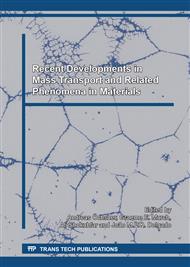[1]
Lin, Y. C., Ming-Song Chen, and Jue Zhong. Effects of deformation temperatures on stress/strain distribution and microstructural evolution of deformed 42CrMo steel., Materials & Design 30. 3 (2009): pp.908-913.
DOI: 10.1016/j.matdes.2008.05.010
Google Scholar
[2]
Calik, A., O. Sahin, and N. Ucar. Mechanical properties of boronized AISI 316, AISI 1040, AISI 1045 and AISI 4140 steels., Acta Physica Polonica A115, no. 3 (2009), pp.694-698.
DOI: 10.12693/aphyspola.115.694
Google Scholar
[3]
Sen, S., Sen, U., & Bindal, C. Tribological properties of oxidised boride coatings grown on AISI 4140 steel. Materials Letters, 60(29), (2006)., pp.3481-3486.
DOI: 10.1016/j.matlet.2006.03.036
Google Scholar
[4]
Oriani, Richard A. Acta Metallurgica 18. 1, (1970), pp.147-157.
Google Scholar
[5]
Bruzzoni Pablo, Bruhl Sonia P., Gómez Bernardo J.A. , Hydrogen permeation modification of 4140 steel by ion nitriding with pulsed plasmas, Surface and Coatings Technology 110 (1998), p.13–18.
DOI: 10.1016/s0257-8972(98)00540-4
Google Scholar
[6]
Quadrini, E., and C. Badini. Effect of boriding surface treatment on hydrogen embrittlement of UNI 30NiCrMo12., Materials chemistry and physics 24. 1 (1989), pp.111-122.
DOI: 10.1016/0254-0584(89)90050-3
Google Scholar
[7]
ASTM E 855-08, Standard Test Methods for Bend Testing of Metallic Flat Materials for Spring Applications Involving Static Loading, American Society of Testing and Materials, 2009, p.779–787.
DOI: 10.1520/e0855
Google Scholar
[8]
Devanathan, M. A. V., and Z. Stachurski. Proceedings of the Royal Society of London. Series A. Mathematical and Physical Sciences 270. 1340 (1962), pp.90-102.
Google Scholar
[9]
Shreir, L. L., R. A. Jarman, and G. T. Burstein. Butterworth-Heinemann, Oxford, England 4 (1994): p.44.
Google Scholar
[10]
ASTM G129-00. Standard Practice for Slow Strain Rate Testing to Evaluate the Susceptibility of Metallic Materials to Environmentally Assisted Cracking., (2004).
DOI: 10.1520/g0129
Google Scholar
[11]
Lopez-Perrusquia, N., Doñu-Ruiz, M.A., Rodríguez-González, S., Rosado Cruz, D.L. and Vasquez-Ramírez, F., Formation of Hard Layers in Tool Steels. In Advanced Materials Research, Vol. 690, (2013), pp.2059-2062. Trans Tech Publications.
DOI: 10.4028/www.scientific.net/amr.690-693.2059
Google Scholar
[12]
Sen, Saduman, Ugur Sen, and C. Bindal. Kinetics of boride layers formed on the surface of AISI 4140 steel., Key Engineering Materials. Vol. 264. (Trans Tech Publications, 2004).
DOI: 10.4028/www.scientific.net/kem.264-268.565
Google Scholar
[13]
AK, Sinha. Boriding (Boronizing), ASM Handbook, V. 4: heat treating., Materials Park, OH: ASM International (1991), pp.437-47.
Google Scholar
[14]
M. Kulka, N. Makuch, A. Pertek, L. Małdziński, Simulation of the growth kinetics of boride layers formed on Fe during gas boriding in H2-BCl3 atmosphere, Journal of Solid State Chemistry, 199, (2013), pp.196-203.
DOI: 10.1016/j.jssc.2012.12.029
Google Scholar
[15]
Sen, S., Sen, U., & Bindal, C., The growth kinetics of borides formed on boronized AISI 4140 steel. Vacuum, 77(2) (2005) 195-202.
DOI: 10.1016/j.vacuum.2004.09.005
Google Scholar
[16]
Doñu Ruiz, M. A., Perrusquia, N. L., Huerta, D. S., San Miguel, C. T., Calderón, G. U., Moreno, E. C., & Suarez, J. C. Growth kinetics of boride coatings formed at the surface AISI M2 during dehydrated paste pack boriding. Thin Solid Films, 596, (2015).
DOI: 10.1016/j.tsf.2015.07.086
Google Scholar
[17]
Günen, A., Kurt, B., Somunkιran, İ., Kanca, E., & Orhan, N. The effect of process conditions in heat-assisted boronizing treatment on the tensile and bending strength characteristics of the AISI-304 austenitic stainless steel. The Physics of Metals and Metallography, 116(9), (2015).
DOI: 10.1134/s0031918x15090021
Google Scholar
[18]
Doñu Ruiz, M. A., Perrusquia, N. L., Sosa, G. U., Gómez, L. H., & Huerta, D. S. Mechanical Behavior on Cr Base Steels Surface Treatment. InDefect & Diffusion Forum (Vol. 365), (2015).
DOI: 10.4028/www.scientific.net/ddf.365.148
Google Scholar


